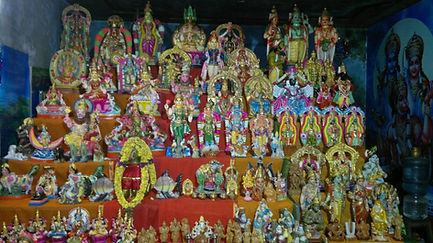Sri Maha Prathyangira Devi Temple
Acerca de

Annadhanam : A Sacred Offering Of Food, Every Sundays
Annadhanam-A Sacred Offering Of Food, Every Sundays
Every Sunday from 12 pm to 3 pm, Annadhanam is provided to all devotees. 1500-3000 people are benefited from this every week.
Annadhanam is often called the best form of dhanam. Because without food life cease to exist. Also, this is one kind of charity where the receiver can say “Enough”. Try giving them money, they need more. Give them clothes, they want a different style or colour. Irrespective of how much food one can offer, the receiver will stop at some point and say, Thank you – I am full.

Yearly Navratri Celebration
Navratri is an important festival for devotees, it is celebrated for nine nights and ten days.
During these nine nights and ten days, nine forms of Devi are worshipped. The tenth day is commonly referred to as Vijayadashami or "Dussehra" (also spelled Dasera).
It is celebrated by :
-
Navratri Golu
-
Classical dance
-
Carnatic Music

Other Important Events
-
On 2nd & 4th Sundays, Group Bajans by Vazhum Kalaigal (Art of Living)
-
Yearly Medical Camps for Devotees
-
Akshara Abhiyasam on Vijayadashmi day

-
Sin is the basis of suffering. Rituals such as homam, & yagnam are prescribed in the Vedas for expiation of sins and for the acquisition of merit/virtue. The general significance behind all these rituals is to seek the help of deities (divine beings) that are capable to deliver one from sins and to make one acquire punyam (merit) to fulfill one's material or spiritual desires.
-
Why fire?
-
Before understanding the significance of homam, it is important to know why only fire and water are used in homam, yagnam and tarpanam. The Vedas proclaim that the entire cosmos is made up of panchabhootas (five elements) in varying proportions. One the basis of the ability to retain and transmit energy, among these five elements, the earth is the heaviest and most concrete. As a medium it can retain energy but cannot transmit it. On the other hand, air and space elements are the lightest of all and are too abstract. They can transmit but cannot retain energy. So, the ancient sages have chosen the fire and water elements for their sadhana to give offerings to the divine beings because these two elements have the best ability to retain and transmit divine energy.
-
Significance of Homam and Agni
-
Just as the five elements exist in the cosmos in the world around us, they exist inside the human body too. Inside the being, Agni (fire) exists in two forms - as Jatara-agni (digestive fire in the physical body) and as Bhoota-agni (internal spiritual fire in the subtle body). In most humans, jatara-agni burns brightly and the bhoota-agni burns low merely as a flickering dim flame. A yogi with his spiritual practices converts the jatara-agni into bhoota-agni. Hence he feels very little/no hunger (due to lack or absence of digestive fire). Bhoota-agni, on the other hand, is spiritual in nature and is capable of sustaining divinity. When a yogi performs the nama/japa/mantra/offerings to a deity, the deity enters into the bhoota-agni and receives the offering directly. This is said so because a yogi's bhoota-agni burns so brightly inside his sookshma sarira (subtle body) that it can sustain within it, the divinity of a deity or any other divine being. Since, a normal human being's bhoota-agni burns poorly, he makes use of an external fire, to invoke the deity into the fire so that the deity may receive the offerings directly from the external fire. In return, the deity fulfills the righteous desire of the person who performs the homam.
-
Out of all the types of rituals prescribed, Homam is the quickest way to derive the deity's grace. Ganapati Homam , Chandi Homam, Sudarshana Homam, Paashupata Homam, Mrityunjaya Homam, Ayush Homam - These are some of the well known homams performed by priests in temples and homes of India. The fire ritual immensely aids in Nadi-shuddi and in maintaining good health. More often than not one feels very cleansed and rejuvenated after performing a fire ritual. The gases that come out of a homa-kunda revitalize the atmosphere and environment around us and promote well being. Many researches have been conducted about the environmental benefits of homam and yagnam. Even today, these results can be witnessed in many cases where rains from the sky drench the earth with showers immediately after the conclusion of a massive fire ritual. In the ancient days, people performed fire rituals everyday. Such people were called Nitya-Agnihotris. Rama was a Nitya Agnihotri too. He performed the worship with fire even during the time of exile in the forests. With the passage of time, lifestyles have changed and mankind lost most of the knowledge about the significance of such ancient rituals.
Poojas & Homams
-
Ashtami Homa to Bhairava and Varahi
-
Every month of Sankata-hara Sathurthi Homam to Uchista Ganapthy
-
High Powered and Pre-Eminent Amavasya homam with 108 herbes, fruits, shrubs, 33 sarees samarpanam
-
Sunday Raaghu Kala Pooja to Sarabeshwarar
-
Friday and Tuesday Raaghu kala Pooja to Raaghu-Ketu
-
Daily Milk Abhishekam to all deities
-
Pournami Pooja to Kaalima












